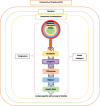Journeying with the Dying-Lessons from Palliative Care Physicians
- PMID: 40741311
- PMCID: PMC12304369
- DOI: 10.1007/s41649-024-00321-5
Journeying with the Dying-Lessons from Palliative Care Physicians
Abstract
Witnessing suffering and death in palliative care can cause moral distress, emotional exhaustion and maladaptive coping strategies. How sense and meaning is made from these experiences influences how physicians think, feel and act as professionals (professional identity formation or PIF). It also determines how they cope with their roles, care for patients and interact with other professionals. Timely, personalised and appropriate support is key as shaping how these physicians develop and contend with sometimes competing beliefs and roles. The Ring Theory of Personhood (RToP) and the Krishna-Pisupati Model (KPM) offer a means of mapping PIF and thus moulding, coping and meaning making. This study uses the RToP and KPM to explore how caring for end-of-life patients impacts the personhood of palliative care physicians. Semi-structured interviews with a purposive sample of 13 palliative care physicians-eleven females and two males aged between 35 and 50 years-at a cancer specialist centre were conducted. Transcripts of the audio-recorded interviews underwent content and thematic analysis where complementary themes and categories identified were combined to form domains that highlighted the physicians' key experience of providing end-of-life care. The domains identified were (1) identity formation, (2) conflicts, (3) KPM elements and (4) support systems. Together, results revealed that palliative care physicians are driven by Innate, Individual, Relational and Societal belief systems that create an intertwined professional and personal identity, enabling them to find meaning in their experiences and adapt to present contexts within cultural norms and professional expectations. However, their failure to recognise their need for support when hampered by evolving personal, existential and clinical factors underlines the exigency for ongoing surveillance and a potential role for a RToP-based tool and portfolio system that can detect and direct timely, appropriate support to in-need physicians.
Supplementary information: The online version contains supplementary material available at 10.1007/s41649-024-00321-5.
Keywords: Death and dying; Doctor-patient relationship; Palliative care; Personhood; Physician–patient relationship; Professional identity formation.
© The Author(s) 2024.
Conflict of interest statement
Competing InterestsThe authors declare no competing interests.
Figures
Similar articles
-
How lived experiences of illness trajectories, burdens of treatment, and social inequalities shape service user and caregiver participation in health and social care: a theory-informed qualitative evidence synthesis.Health Soc Care Deliv Res. 2025 Jun;13(24):1-120. doi: 10.3310/HGTQ8159. Health Soc Care Deliv Res. 2025. PMID: 40548558
-
Sexual Harassment and Prevention Training.2024 Mar 29. In: StatPearls [Internet]. Treasure Island (FL): StatPearls Publishing; 2025 Jan–. 2024 Mar 29. In: StatPearls [Internet]. Treasure Island (FL): StatPearls Publishing; 2025 Jan–. PMID: 36508513 Free Books & Documents.
-
Adapting Safety Plans for Autistic Adults with Involvement from the Autism Community.Autism Adulthood. 2025 May 28;7(3):293-302. doi: 10.1089/aut.2023.0124. eCollection 2025 Jun. Autism Adulthood. 2025. PMID: 40539213
-
"It's a tool, it's got hardships": a qualitative study of patient experience of colonoscopy and implications for trauma-informed care.Therap Adv Gastroenterol. 2025 Jun 21;18:17562848251346250. doi: 10.1177/17562848251346250. eCollection 2025. Therap Adv Gastroenterol. 2025. PMID: 40547252 Free PMC article.
-
Survivor, family and professional experiences of psychosocial interventions for sexual abuse and violence: a qualitative evidence synthesis.Cochrane Database Syst Rev. 2022 Oct 4;10(10):CD013648. doi: 10.1002/14651858.CD013648.pub2. Cochrane Database Syst Rev. 2022. PMID: 36194890 Free PMC article.
References
-
- Bok, Chermaine, Cheng Han Ng, Jeffrey Wei Heng Koh, Zhi Hao Ong, Haziratul Zakirah Binte Ghazali, Lorraine Hui En Tan, Yun Ting Ong, Clarissa Wei Shuen Cheong, Annelissa Mien Chew Chin, Stephen Mason, and Lalit Kumar Radha Krishna. 2020. “Interprofessional communication (IPC) for medical students: A scoping review.” BMC Medical Education 20 (1): 372. 10.1186/s12909-020-02296-x. - PMC - PubMed
-
- Braun, Virginia, and Victoria Clarke. 2006. Using thematic analysis in psychology. Qualitative Research in Psychology 3 (2): 77–101. 10.1191/1478088706qp063oa.
-
- Braun, Virginia, and Victoria Clarke. 2019. Reflecting on reflexive thematic analysis. Qualitative Research in Sport, Exercise and Health 11 (4): 589–597. 10.1080/2159676X.2019.1628806.
-
- Chan, Natalie Pei Xin, Jeng Long Chia, Chong Yao Ho, Lisa Xin Ling Ngiam, Joshua Tze Yin Kuek, Nur Haidah Binte Ahmad Kamal, Ahmad Bin Hanifah Marican Abdurrahman, Yun Ting Ong, Min Chiam, Alexia Sze Inn Lee, Annelissa Mien Chew Chin, Stephen Mason, and Lalit Kumar Radha Krishna. 2021. Extending the ring theory of personhood to the care of dying patients in intensive care units. Asian Bioethics Review 14 (1): 71–86. 10.1007/s41649-021-00192-0. - PMC - PubMed
LinkOut - more resources
Full Text Sources



